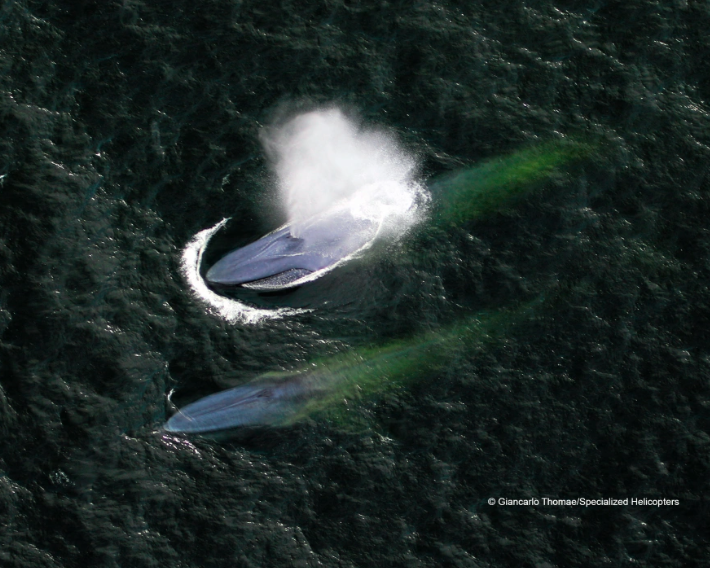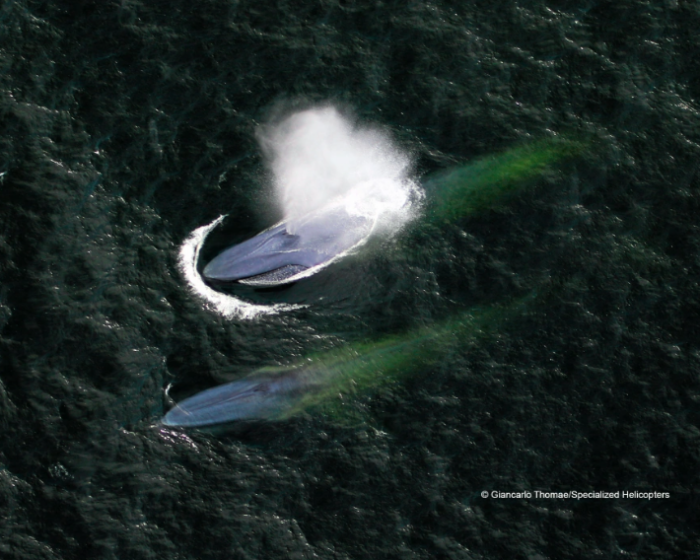Monterey Bay National Marine Sanctuary likened to the “Serengeti of the Sea,” is world-renowned for its mammal, bird and habitat diversity. One sanctuary visitor coming to feed is the blue whale, the largest animal ever to have existed on Earth. The sanctuary is also near some of the busiest ocean “superhighways” though, with huge vessels bringing needed goods to the ports of San Francisco and Los Angeles.
Too often, we have seen the result of ship strikes to whales, who share the ocean highway with container ships. Several vessel separation schemes organize ship traffic through the sanctuary; for example, one scheme pushes hazardous cargo offshore. Whales, however, don’t adhere to any boundaries or traffic lanes in the ocean, so how do we accommodate marine commerce and migrating whales?
The Monterey Bay Sanctuary has joined other California sanctuaries, California air pollution control districts, and nonprofit organizations in the Protecting Blue Whales and Blue Skies program, a voluntary vessel speed reduction program. Global shipping companies have recognized the need to provide a safer environment for whales off the California coast by reducing speeds through areas where whales are most likely to be. Reducing speed also helps reduce air pollution and ocean noise, benefiting humans and the environment as well.
Each year, shipping companies receive positive press and recognition from Protecting Blue Whales and Blue Skies, based on their level of cooperation with reducing speed through the Vessel Speed Reduction zones in and around sanctuaries. Cooperating ships reduce their speed to 10 knots or less with an average speed of 12 knots or less.
The program runs May through mid-December each year, which coincides with peak whale season and when ground-level ozone (smog) concentrations are typically high. The 10-knot target allows ships to travel at an efficient operating load, using less fuel and producing less pollution.
Sustainable shipping is important to shipping companies, and is also a growing concern for manufacturers, retailers, and cargo owners. Brands and retailers now have a way to be part of the solution by working alongside the shipping industry through the Brand Ambassador Initiative of the program.
“Historically, companies and retailers that rely on ocean freight have little information about the regional environmental impacts of the ships carrying their products,” said Amber McEldowney, Blue Whales and Blue Skies Program Associate.
“The Brand Ambassador Initiative provides brands with information about their shipping companies’ participation in the Protecting Blue Whales and Blue Skies program and the resulting environmental benefits as they transit from their origin to the California coast.”
Companies that have joined the Brand Ambassador Initiative are in a variety of industries spanning from coffee to consumer goods, united by their commitment to protect natural resources. Early companies on board include Nomad Goods, Peak Design, Summit Coffee, Way Basics, Santa Cruz Bicycles, Who Gives a Crap, and the Port of Hueneme. Together, the seven Brand Ambassadors ship with 13 different shipping companies in the Blue Whales and Blue Skies program. Brand Ambassadors communicate with shipping companies and drive the demand for more sustainable shipping practices. As a result, brands are recognized in the program for their participation and positive impact. The goal is to improve conservation outcomes for whales, people and the planet.
Interested community members can sign a pledge, share social media information, or correspond with decision-makers, including brand representatives who make shipping decisions. Community support for the Protecting Blue Whales and Blue Skies program spreads awareness of sustainable shipping practices, increases engagement with brands and shipping companies, and promotes innovative solutions for cleaner air, safer whales, and a quieter ocean.


